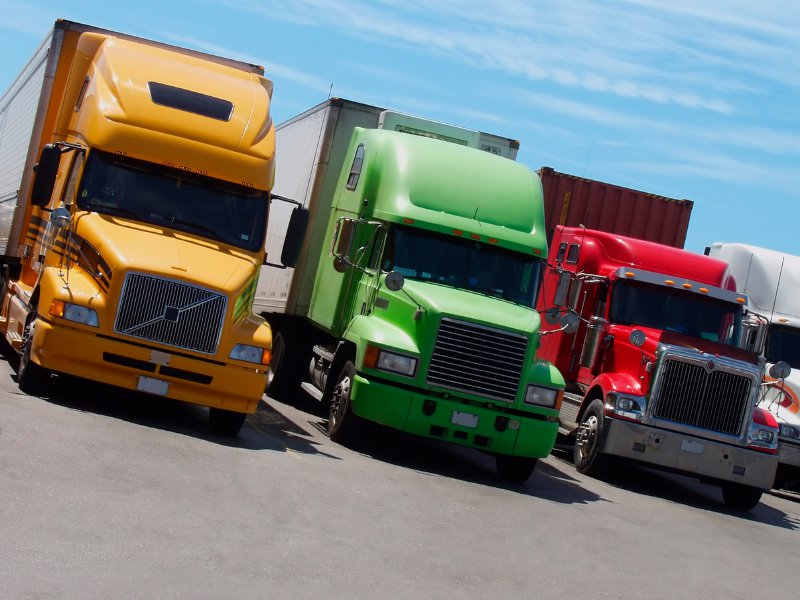
25 Jun ELD – Electronic Logging Devices
Overview
Ever since December 10th, 2015, the FMCSA (Federal Motor Carrier Safety Administration) has required commercial trucking companies to use Electronic Logging Devices (ELDs) to accurately record their HOSs (Hours of Service). The FMCSA says that the new rules were created to improve commercial vehicle safety on the highways.
ELD Foundations
The new rules may be different, and the transition may take some companies a while to adjust to, but the government has made its guidelines clear, and commercial companies are starting to get more and more onboard as the months go by.

What is an ELD
Electronic Logging Device (ELD) mandates have brought about some important regulatory governmental initiatives. ELDs themselves are used to reduce accidents, fatalities, and to get fatigued drivers off the road when they need to rest. ELDs make record keeping easier, and immensely streamline the process.
How does an ELD work?
ELD devices automatically record the time a driver has been behind the wheel, and also lets drivers easily update their duty status. It allows them an easier way to edit their logs, and allows a vehicle’s engine to collect information through an electronic control module, or ECM. ELDs must be tamper proof, and must protect the privacy of the driver. Drivers will now have the option of using an easy mobile app to do their recordings.
FMCSA Requirements
As with many regulations, the ELD mandate has taken years to research the logging technology, analyze the regulatory impact, gather public feedback, publish the final rule, and prepare the industry. Some have since wondered whether the ELD mandate will move forward, be amended, or be withdrawn. There has been no indication, however, that the mandate will be withdrawn or amended, and many trucking companies have already moved forward and purchased an ELD so they can be compliant.
In addition to compliance, many carriers have made the move to ELD because the price of an alternative AOBRD is more expensive – often ranging between $500 and $2,000 whereas an ELD’s price generally ranges between $100 and $200. Carriers are also realizing benefits by the simultaneous convergence of fleet drivers moving from AOBRDs to ELDs and owner-operators moving from paper to ELDs. For the first time, the fleet can now have all drivers using the same type of technology.
Mandate Summary
Records of Duty Status (RODS) and HOS record keeping are the main reasons commercial drivers will now be required to use ELDs. According to the FMCSA, over three million drivers and their companies will have to follow the new regulations. For example, out of a 30-day period, any drivers who use paper RODS for more than eight days will be required to use an ELD, along with drivers who are now using AOBRDs.
Mandate Exceptions5:
- Using paper duty status records for not more than 8 days out of every 30 days.
- Operating a vehicle that was manufactured prior to the year 2000.
- Driving a vehicle that is also the product to be delivered (drive-away/tow-away).
- Using time cards while conducting short-haul operations covered by an exemption.
Mandate Timeline
If you are required to comply with the new ELD mandate, you must install
and use ELDs by the following deadlines:

The timeline below summarizes the important dates and regulatory actions of the ELD Mandate
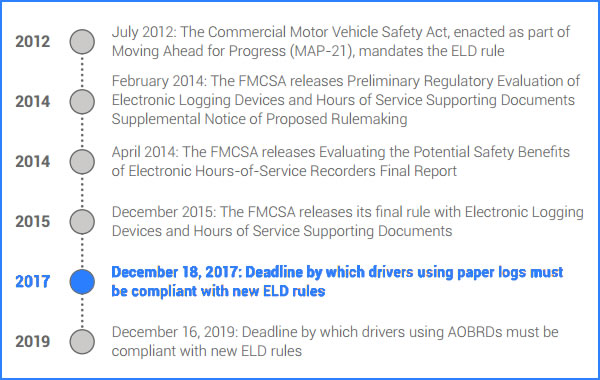
Multi-phased Approach
The FMCSA has organized the ruling into three phases of implementation and compliance.
They are summarized in the table and descriptions below.
Approved Log Methods by Phase6

Phase 1: Awareness and Transition
This is the phase when carriers and drivers will be essentially still getting used to using newly installed ELDs, understanding the new regulations, and preparing to comply with the new mandate.
Phase 2: Phased-in Compliance
This phase is when any drivers or carriers who are subject to the rules will begin to use ELDs, although some AOBRDs that were installed before the second phase may still be in use.
Phase 3: Full Compliance
This phase is when every driver and carrier under the rules of the mandate must fully meet the ELD rules by using ELDs that are in line with the current requirements.
Facts and Figures
The ELD mandate aims to save time and money as well as improve safety and compliance.
Listed below are some interesting stats behind the mandate.
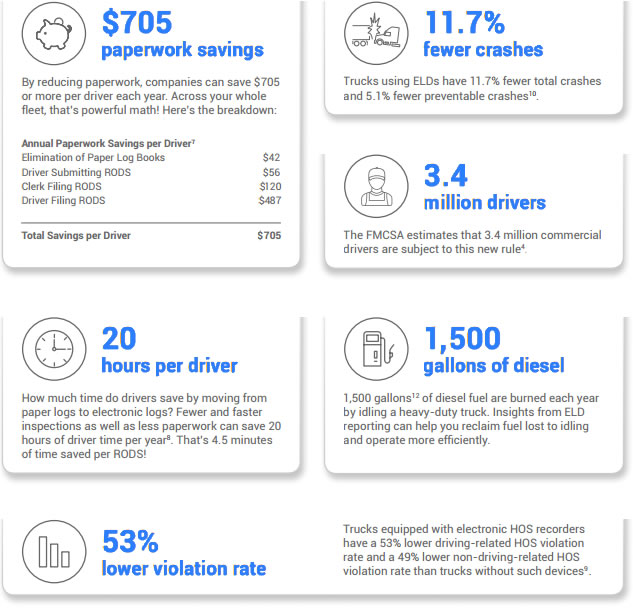
Benefits of Using ELDs
The following categories can be can be used to help fleets and drivers
better understand how the ELD mandate is beneficial.
ELDs will save drivers and carriers lots of time and energy, being that there will be less paperwork to go through every day. Ultimately, this will mean more revenue, because more time can be spent on work than record keeping.
Drivers have enough to deal with when they are out working, and many of them realize how much of a headache the paperwork burden can be while they are out in the field. ELD use will streamline this process, and save the driver hundreds of extra dollars annually.
The use of ELDs can also improve the reputation of a driver or carrier. Being that less focus will be on paperwork, now they can focus more on the concerns of the client, and give them more of the personal attention they deserve.
The time and money saved by using ELDs in addition to the increased safety out on the highways (with the reduction of occurrences such as driver fatigue) have more and more companies looking forward to the complete transition.
How to Introduce to Drivers
Carriers have to make their drivers see the many positives of using ELDs. For example, all the tedious paperwork tasks they had to perform before that took up so many precious minutes out of their workdays will be a thing of the past. The speed and accuracy of an ELD system will free the drivers up to increasing their own daily productivity.
Drivers will save gallons of fuel by using ELDs, as well as increase their own personal safety. Another benefit drivers love is better navigation, along with the fact that record keeping will now be a thing that they won’t have to burn so much mental energy on every shift.
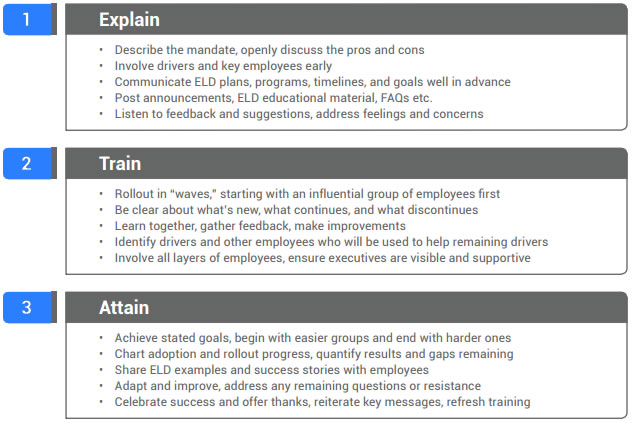
Checklist for Success
If you need to comply with the ELD mandate, now is the time to take action. Here are a few steps to help you get started.
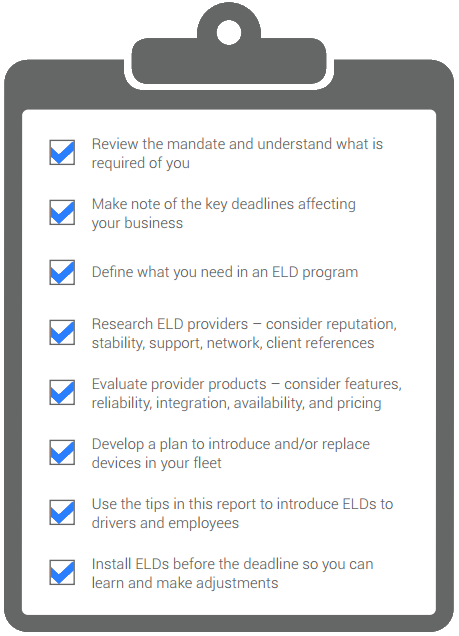
The FMCSA also provides an ELD checklist for both drivers and carriers on its website:
Carriers: https://www.fmcsa.dot.gov/hours-service/elds/eld-checklist-carriers
Drivers: https://www.fmcsa.dot.gov/hours-service/elds/eld-checklist-drivers


No Comments